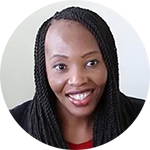Stopping HIV, One School at a Time

In schools across South Africa, teachers are one of the most important groups of defenders against the spread of HIV. EDC’s Viwe Mtshontshi has been leading an effort to prepare between 5,000 and 10,000 South African teachers to deliver sexuality education and HIV awareness programming—creating a teaching corps that could reach half a million students in grades 4 through 12.
Mtshontshi is optimistic that this educational approach can both prevent the further spread of HIV and change prevalent attitudes about people living with the virus. In this Q&A, she discusses some of the challenges of early prevention and offers lessons for others in the field.
Q: Why is it so effective in South Africa to focus HIV prevention efforts on schools?
Mtshontshi: Education is compulsory in South Africa, and the country has one of the highest school enrollment rates in Africa. So we know that we have a significant captive audience there. Focusing on schools allows us to provide a lot of young people with vital health information that they may not get anywhere else.
It is best for children to learn about health, sexuality, and prevention from a trusted adult. Classroom teachers are well positioned to do this, especially because a significant number of children in South Africa are either orphans or live in child-headed households. The school really becomes the place where children are getting information about healthy living because their parents are not around to provide it.
Q: What messages do you want educators to deliver to students?
Mtshontshi: The most important idea in our curriculum is that your health is your responsibility. Regardless of the topic, all of the lessons emphasize the perspective of positive health. Teachers work on this from a very young age, starting with simple things like washing hands.
Teachers start talking about sex and sexuality in grade 4. Our curriculum emphasizes six core messages: the safest choice is not to have sex; you have a right to say no to sex in any situation; if you choose to have sex, use a condom every time; if you are having sex, get tested for HIV and other STIs regularly; stay faithful to one partner at a time to protect yourself and your partner; and both men and women are responsible for preventing pregnancy, HIV, and other STIs.
Q: How do you help educators talk to students about challenging topics such as HIV and sexuality?
Mtshontshi: With teachers, we use scripted lessons, which gives them the content they need and the methods in which they should deliver it. It makes the teachers’ job much easier, since they do not have to develop any content—they are merely there to deliver and facilitate the lesson. We also support educators and learners through mentoring and coaching, and we sensitize the parents. So, we use a comprehensive approach.
Q: How have you dealt with taboos surrounding discussions of sexuality and HIV?
An important part of the educator training addresses teachers’ comfort levels in discussing sexuality, while also providing accurate information that can help reduce risky behavior. In many cultural contexts, it is not an easy topic to discuss. Even though many teachers and learners have been affected by HIV, the stigma has been challenging to overcome, as people still have a lot of prejudices. Unpacking ideas of gender, sex, orientation, and what it means to be LGBTIQ—these have been the more difficult conversations.
Q: What can other countries learn from the success of this work in South Africa?
Mtshontshi: It’s not easy work. When you talk about sex and sexuality with children, you encounter many cultural norms, values, and contexts that you need to consider. I think we have been successful because our curriculum is evidence-based and gives teachers a concrete script they can use. In addition, we have had a high degree of commitment from the country’s Department of Basic Education. We are all working toward an AIDS-free generation together.
This work is funded by the U.S. Agency for International Development under the PEPFAR program.
